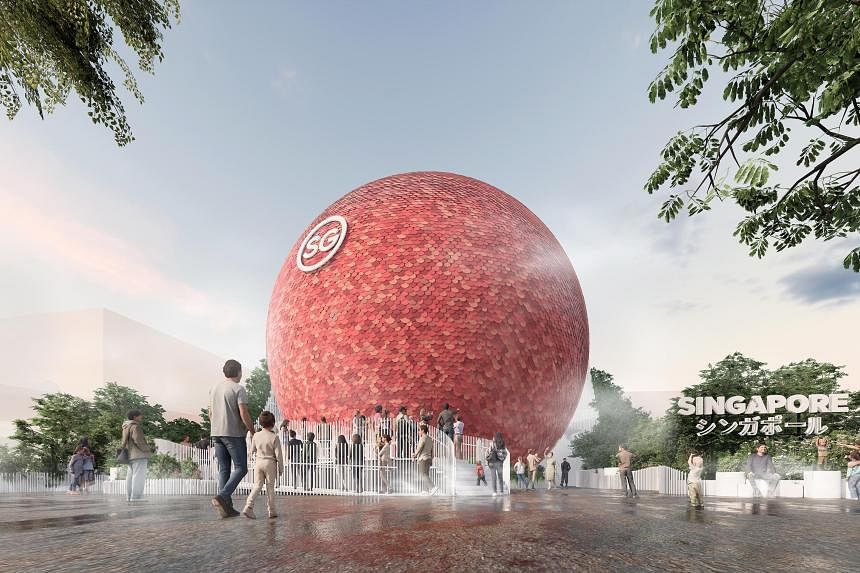OSAKA – From sweeping vistas of lush, island greenery replete with tropical birds, fish and alligators in pits to a sleek, dreamlike vision of the future, Singapore’s World Expo journey has come full circle, from its first foray in Osaka, Japan, in 1970, and back there again in 2025.
The idea of Singapore as a “Little Red Dot”, its people unfazed by the nation’s size as they turn their hopes into reality, forms the core of the Republic’s pavilion at the Osaka World Expo that will kick off in less than a year, the Singapore Tourism Board (STB) said on April 15.
Singapore has been a firm supporter of the World Expo, a once-in-five-year event that will be hosted by Osaka from April 13 to Oct 13, 2025.
The anticipated tourism bonanza will be held on the man-made Osaka Bay island of Yumeshima, which translates as Dream Island and is where Japan is due to open its first integrated resort in 2030.
Singapore’s pavilion, a vibrant red hue in the shape of an orb aptly named the Dream Sphere, bears the tag line, Where Dreams Take Shape. It sits on a 900 sq m plot of land, with a diameter of 18.5m, and stands 17m tall – or about seven storeys – at its highest.
Osaka Expo organisers expect 28.2 million visitors, including 3.5 million from abroad, to attend the event, which is themed Designing Future Society For Our Lives.
But the extravaganza has been plagued with bad press due to massive cost overruns, construction delays and tepid interest.
“World Expos are grand and complex endeavours,” Singapore’s Ambassador to Japan Ong Eng Chuan said at a concept-unveiling event on April 15.
“Hosts and participants alike face many challenges, including to create an excellent experience for visitors and to ensure the World Expo leaves a lasting and positive impact on the world,” he added.
Japan is hosting the World Expo for the third time, most recently in Aichi in 2005.
Osaka also hosted the jamboree in 1970, which marked the first time the World Expo was held in Asia. That was also Singapore’s first time participating, with its pavilion showcasing a tropical garden paradise.
“The 1970 Osaka Expo took place five years after Singapore’s independence, but even then, we knew we had to participate,” Mr Ong told reporters at The Garden Oriental Osaka, a European-style building that was built in 1959 and was once a state guest house that has hosted visiting dignitaries.
Now, the expo is returning to Osaka, with the event coinciding with Singapore’s celebration of 60 years of independence in 2025.
This makes it an opportune time to “convey our belief in the power of bringing together our dreams, connecting people, and thus building a better future”, Mr Ong said.
“We hope the Singapore Pavilion can stretch imaginations and give us a glimpse of what Singapore and Japan can do together in the future.”
At the pavilion, the STB will showcase the best that Singapore has to offer in food, culture, the arts and innovation, hoping to “inspire and invite visitors to explore the infinite possibilities of dreams”.
As it is, the red sphere was inspired by the derisive-turned-endearing moniker Little Red Dot, which the production team of DP Architects and Kingsmen Exhibits had hoped to use to showcase the collective spirit behind the Singapore Story, told through Singapore food and heritage.
Osaka Vice-Governor Nobuhiko Yamaguchi praised Singapore as a “top runner” in being the first to start construction, while the expo’s secretary-general Hiroyuki Ishige said he was impressed by the powerful design and facade.
On Jan 10, Singapore became the first country to break ground and start building its pavilion, a $36 million project that aims to astonish both in its scale and unorthodox spherical design.
On the dream sphere’s similarity in shape and colour to some Japanese elements, STB assistant chief executive Juliana Kua noted that a few Japanese people have said that the crimson orb reminded them of the ume (Japanese plum). “I understand this is something very dear to Japanese and their culture. We really hope this pavilion can create an even deeper connection between our people.”
Mr Seah Chee Huang, chief executive of DP Architects, said: “Both countries share the same national colour hues – white and red – and the convergence is quite magical and coincidental too.”
The pavilion is built on the foundation of 4Rs – renew, reuse, reduce and recycle – and true to the message of sustainability, its components can be easily disassembled for recycling or other uses after the expo ends, he added.
While nothing has been decided with regard to the Singapore Pavilion’s post-expo fate, its facade alone comprises more than 20,000 discs made of recycled aluminium. This approach would save an estimated 104 tonnes of carbon dioxide emissions, or the equivalent amount absorbed by 4,100 trees annually.
With it being 60 years since independence, Kingsmen Exhibits group managing director Anthony Chong said: “We will celebrate our nation’s achievements, our aspirations, and our people with the Singapore pavilion… Dreams are the catalyst for progress.”
A teaser video played on April 15 at the event showed the pavilion’s red sphere against a backdrop of familiar Singaporean settings, such as a Housing Board estate and the Marina Bay area.
About 160 countries and regions will participate in the Osaka Expo in 2025. Advance ticket sales have begun, costing between 4,000 yen (S$35.30) and 6,700 yen for an adult, depending on when they are bought and when they will be used. Tickets sold at the event cost 7,500 yen each.


